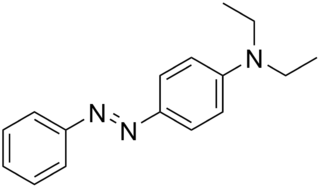
Congo red is an organic compound, the sodium salt of 3,3′-([1,1′-biphenyl]-4,4′-diyl)bis(4-aminonaphthalene-1-sulfonic acid). It is an azo dye. Congo red is water-soluble, yielding a red colloidal solution; its solubility is greater in organic solvents. However, the use of Congo red has long been abandoned, primarily because of its carcinogenic properties.

Azo compounds are compounds bearing the functional group diazenyl R−N=N−R′, in which R and R′ can be either aryl or alkyl.

Sudan I, is an organic compound, typically classified as an azo dye. It is an intensely orange-red solid that is added to colourise waxes, oils, petrol, solvents, and polishes. Sudan I has also been adopted for colouring various foodstuffs, especially curry powder and chili powder, although the use of Sudan I in foods is now banned in many countries, because Sudan I, Sudan III, and Sudan IV have been classified as category 3 carcinogens by the International Agency for Research on Cancer. Sudan I is still used in some orange-coloured smoke formulations and as a colouring for cotton refuse used in chemistry experiments.

An acid dye is a dye that is typically applied to a textile at low pH. They are mainly used to dye wool, not cotton fabrics. Some acid dyes are used as food colorants, and some can also be used to stain organelles in the medical field.

Mordant red 19 is an organic compound with the chemical formula C16H13ClN4O5S. It is classified as an azo dye.

Azo dyes are organic compounds bearing the functional group R−N=N−R′, in which R and R′ are usually aryl. They are a commercially important family of azo compounds, i.e. compounds containing the linkage C-N=N-C. Azo dyes are widely used to treat textiles, leather articles, and some foods. Chemically related to azo dyes are azo pigments, which are insoluble in water and other solvents.
An azo coupling is an organic reaction between a diazonium compound and another aromatic compound that produces an azo compound. In this electrophilic aromatic substitution reaction, the aryldiazonium cation is the electrophile and the activated arene is a nucleophile. In most cases, including the examples below, the diazonium compound is also aromatic.
Trypan blue is an azo dye. It is a direct dye for cotton textiles. In biosciences, it is used as a vital stain to selectively colour dead tissues or cells blue.
A substantive dye or direct dye is a dye that adheres to its substrate, typically a textile, by non-ionic forces.
Solvent Black 3 is an azo dye. It is nonfluorescent, relatively thermostable lysochrome diazo dye used for staining of neutral triglycerides and lipids on frozen sections and some lipoproteins on paraffin sections. It has the appearance of a dark brown to black powder with maximum absorption at 596–605 nm and melting point 120–124 °C. It stains blue-black.

Sudan Yellow a3G, also known as Solvent Yellow 16, C.I. disperse yellow and C.I. 12700, is a yellow azo dye. It is soluble in fats and oils.

Solvent Yellow 56 is the organic compound N,N-diethyl-p-(phenylazo)aniline. It is an azo dye, which has the appearance of a reddish yellow powder. Its EINECS number is 219-616-8. Its structure is similar to Solvent Yellow 124, which used as a fuel dye in European Union, and to Aniline Yellow.

Acid orange 7, also known as 2-naphthol orange and Orange II, is an azo dye. It is used for dyeing wool. It is produced by azo coupling of β-naphthol and diazonium derivative of sulfanilic acid.

Direct Blue 1 is an organic compound that is one of many azo dyes. It is used as a substantive dye for textiles with high contents of cellulose, i.e. cotton. It is prepared by the azo coupling of the aminonaphthalene and diazotized derivative of o-dianisidine.

Acid red 88 is an azo dye. Due to its intense colour, solid samples appear almost black. It is used to dye cotton textiles red. A closely related acid dye is Acid Red 13.
Direct Blue 15 is an organic compound that is classified as an azo dye. It is a dark blue water soluble solid. It is a popular substantive dye, which means that it useful for dying cotton and related cellulosic materials. It is produced by azo coupling of o-dianisidine with the appropriate naphthalene disulfonate.

Acid Red 13 is an azo dye. It is produced as a sodium salt. Solid sample appear dark red.

N-Ethyl-N-(2-chloroethyl)aniline is the organic compound with the formula C6H5N(Et)(CH2CH2Cl) (Et = ethyl). It is a low-melting colorless solid that is an alkylating agent. The compound is a precursor to several cationic azo dyes via reaction of the chloroethyl group with tertiary amines or pyridine followed by azo coupling. Examples of derived dyes include C. I. Basic Red 18, Maxilon Red 2GL, and Yoracryl Red 2G.

Metal-complex dyes are a family of dyes that contain metals coordinated to the organic portion. Many azo dyes, especially those derived form naphthols, form metal complexes by complexation of one of the azo nitrogen centers. The insertion of the metal into the organic ligand often involves redox reactions, e.g. pre-reaction of sodium dichromate with glucose. Phthalocyanine (Pc) complexes, such as CuPc, are another important family of metal complex dyes.

o-Dianisidine is an organic compound with the formula [(CH3O)(H2N)C6H3]2. A colorless or white solid, it is a bifunctional compound derived via the benzidine rearrangement from o-anisidine.














